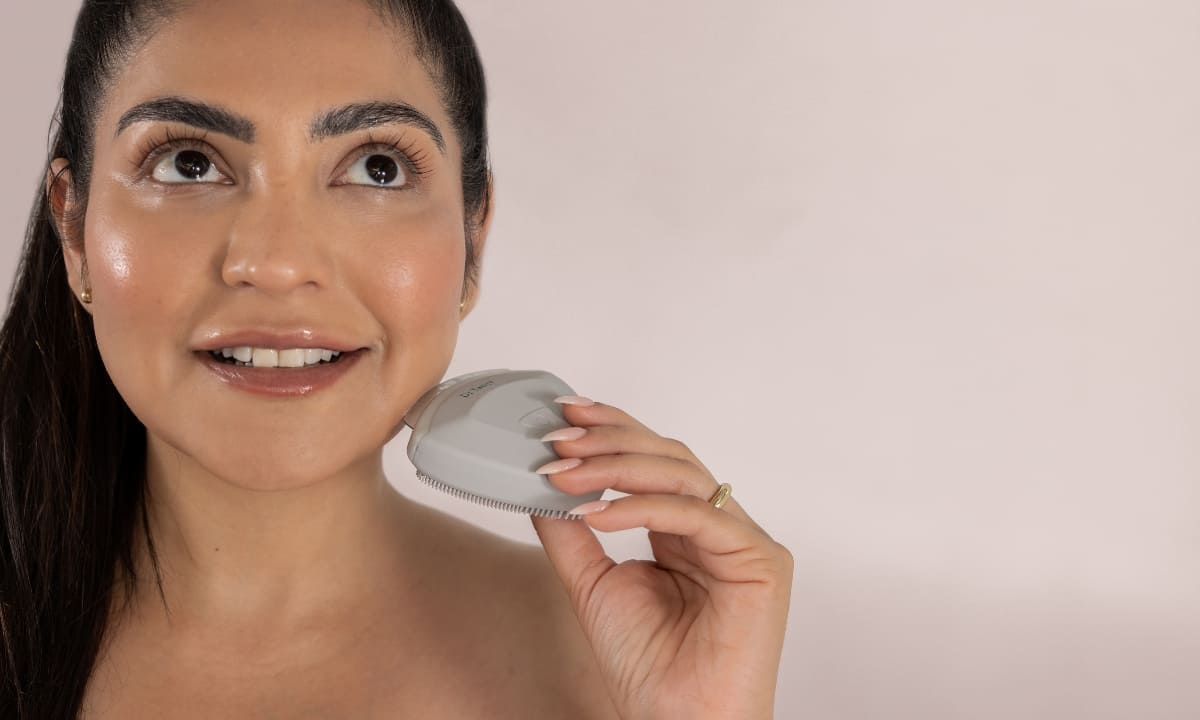
The Best Facial Exfoliator Tool and Methods of 2024
|
|
Time to read 6 min
|
|
Time to read 6 min
Do you exfoliate your skin? Exfoliation is a little contested these days, with many people asking “does exfoliation cause breakouts?” or “is exfoliation really necessary?”
We think the reason these question marks hover over exfoliation is that many of us simply don’t know how to exfoliate properly. In reality, gentle exfoliation has so many benefits and is key to revealing radiant, healthy skin. It buffs away dead skin cells, encourages collagen production, and allows your skincare products to work more effectively.
With the right exfoliation method, you can brighten your complexion, improve skin texture, and keep your skin glowing. But it’s crucial to find the best facial exfoliator for your skin type and concerns—and to learn how to exfoliate properly without overdoing it!
Table of content
First, let’s do a quick recap of how to correctly exfoliate step-by-step:
OR
We’re going to single this one out because, unfortunately, sensitive skin can be tricky to exfoliate—but it is possible, and it still needs gentle care to stay smooth and clear.
The challenge is finding the balance between removing dead cells without causing irritation. The best facial exfoliator for sensitive skin is one that’s gentle but effective.
Opt for enzyme-based exfoliators or low concentration alpha hydroxy acids (AHAs), which dissolve dead skin without harsh scrubbing.
Physical exfoliators can work too—just ensure they have smooth, rounded particles like those in the NuSonic Facial Exfoliator 2.0, which is designed to be non-abrasive yet highly effective.
Remember, the key to exfoliating with sensitive skin is gentleness. Start slow, just once a week, and observe how your skin reacts.
We recommend exfoliating no more than once a week if you have sensitive skin. If you notice any adverse reactions, switch up to a gentler exfoliant or ask a dermatologist about what kind of product you should use.
[Read Full Article: The Best Exfoliator Methods Based on Your Skin Type]
Incorporating exfoliation into your morning or nightly skincare routine doesn't have to be a hassle. There are so many products and formulas and tools on the market, and so much contradictory advice, that it can feel easier to simply throw in the (face) towel and forget about exfoliation altogether.
Stop right there and take a pause! There are easy ways to exfoliate your skin that fit into even the busiest schedule, and that cut through the skincare advice noise online:
Knowing when to exfoliate your face is crucial for healthy skin, and this is an element to exfoliation that many of us get wrong—which is where the problems lie. The solution starts with knowing your skin type and using that to determine your exfoliation ritual.
Always pay attention to how your skin feels post-exfoliation. If it’s feeling too tight or looks red, pull back on how often you exfoliate. Your skin will tell you when enough is enough!
Once you've exfoliated, your skin is more receptive to treatments (which we love), but it’s also more vulnerable. Always follow up with ultra-hydrating products to replenish moisture.
Consider soothing serums like the Holy Basil Face Serum, which calms the skin, or the Radiant Day Cream to lock in hydration.
And don’t skip the sunscreen—exfoliated skin is more sensitive to UV damage, so proper sun protection is a must. But that goes for all the time, so it’s not news to you, we’re sure!
When choosing products for your post-exfoliation care, opt for formulas which contain these key ingredients:
There are several do’s and don’ts of facial exfoliation. Over-exfoliation is one of the most common “don’ts”, and it can lead to issues like redness, sensitivity, and even breakouts.
It can also give exfoliation a bad rap, as some may think they’re exfoliating correctly when they’re actually overdoing it, leading them to believe that this vital skincare step is damaging.
Signs you’re over-exfoliating? Your skin feels tight, dry, or has become unusually sensitive. If you’re prone to acne and you notice breakouts in the days after you exfoliate, that could be another sign you’re doing a little too much.
Avoid using harsh, abrasive scrubs or tools that may tear the skin. Instead, stick with gentle exfoliators, like the best facial exfoliator tailored for your skin type. And always err on the side of less when in doubt—slow and steady wins the race for healthy, glowing skin.
Okay, call us biased—we’ll accept it! We just can’t go past the holy grail of facial exfoliators—Dr Tanya’s NuSonic 2.0—for every skin type.
Here’s why the NuSonic is the best facial exfoliator you can use:
The best way depends on your skin type—opt for chemical exfoliants for sensitive skin or physical exfoliants for normal to oily skin.
A combination of both chemical and physical exfoliation can deliver optimal results, depending on your needs. When it comes to at-home exfoliation, a gentle exfoliating brush combined with your favourite cleanser is recommended.
Ingredients like papaya enzymes, oatmeal, and sugar make great natural exfoliants, especially for those looking for a gentle, eco-friendly option.
You should cleanse your face before exfoliating. Cleansing removes dirt, oil, and makeup from the skin’s surface, ensuring a clean base for exfoliation.
By starting with a cleanser, you allow your exfoliator to work more effectively, as it can then focus on removing dead skin cells rather than surface debris.
After exfoliating, follow up with a hydrating serum and moisturiser to keep your skin balanced and nourished.


